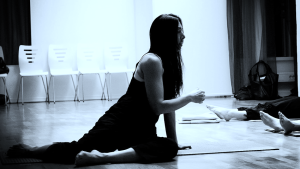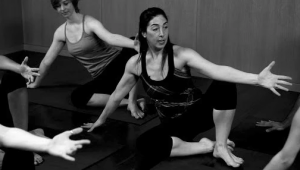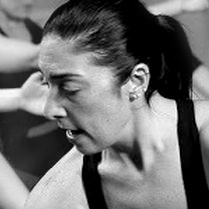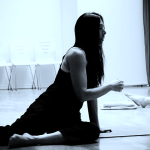Cueing Stabilization
by Teri Lee Steele
September 11, 2019
Recently, I overheard an instructor at a teacher’s conference ask, “How do you know if you are becoming a good teacher?” To which she answered, “Look at your students. Are they doing what you are asking of them?”
This brought many thoughts into my mind as I had just begun teaching my Steele Pilates Mat Certification course. I often receive questions from my student teachers in this regard, wondering how they know if their students are doing each exercise correctly as well as how they should go about fixing the exercise if it is not being performed well.
I think what needs to be addressed is identifying the client’s current abilities and managing your expectations for them. We always seek to obtain the best possible form in each exercise, but this can be tricky for people who have seen the beautiful dancers and movers performing Pilates to the standard we all aspire to achieve. That said, it is important to understand each client’s abilities and limitations and work towards each exercise from the inside out, cueing from the skeleton and breath, so that their best form is achieved without pushing them past where they should go at their current level.
I love hearing from clients that they feel stronger, have less pain, and/or move with greater ease. These are all goals that I have for my clients over time. But how do you know, during the flow of a group class or individual session, that your cueing is affecting the exercise and working towards success?
I like to approach my cueing in layers.

First, I feel it is important for me to build and maintain a very intimate relationship with each exercise I teach. Not that the teacher must be able to perform the work flawlessly, but I find my verbal cueing to be most effective when I am telling my students what they should be thinking about during each phase of the exercise based upon my own thoughts when I do it myself. This creates an organic stream of thought as well as what I have termed “Physical Empathy” which allows me to modify tempo, movement and breath cues appropriately.
Second, I have learned over time what “tends to go wrong” during each exercise and I preemptively cue my class in an attempt to prevent those things from happening. Most importantly, I cue from the movement principles of stabilization, focus, intent, breath, range of motion, and balance. During each exercise, if I see something is “off”, I do a mental check of those components and ask myself “Did I not cue them correctly?” and “What is out of order here and which principles are not being attended to?” I always find my answers within those questions and then I know how to fix things.
Stabilization is the first movement principle of Pilates that I look to when seeking to correct my class. It was originally defined to me as “initiating movement from a stable base.” This makes sense to me in terms of setting up each client properly in order to allow them to succeed during each exercise. Once the exercise begins, stabilization broadens to include an understanding of what is stable against that which is moving. In shoulder differentiation, the ribcage and spine are fixed against the movement of the arms. In hip differentiation, the pelvis and spine are stabilized against the load provided by the weight of the legs moving away from the midline. And how you position the client relative to the pull of gravity affects the workload of each of those exercises. I hear many teachers give the instruction to “stabilize” during exercises, but not often do I hear them tell their students how to accomplish that.
In private sessions, there is a lot more freedom to explore how to accomplish movements – you can repeat movements as many times as required to achieve the desired result. When teaching group classes, we are not afforded the luxury of extra time to spend researching solutions to each individual’s issues; my duty to them is to give them a positive movement experience and work towards their goals of moving fluidly through the hour to increase their strength, flexibility and overall endurance. Thus, I have had to develop efficient ways of cueing each exercise so that each student can respond to the best of their ability as well as understand what I am asking of them (as well as why I am asking them to move certain ways).
Stabilization, I have found, is easiest to cue actively. I now define stabilization as “co-isometric contraction of antagonistic muscle groups around a joint so that no movement occurs.” Understanding what this means, as well as what movements I often see performed incorrectly along with what I wish to stabilize, gives me the information and power to cue them correctly.

A good example of this is during the Roll Up – starting supine with the spine in a neutral position, heels in line with the sit bones and legs extended. Inhale to prepare and, with an active exhalation, flex the upper spine via a cervical nod, curl and then a downward thoracic rotation. It is when the lower ribcage lifts off the floor, taking the spine from upper spinal flexion on a neutral pelvis to full c-curve flexion that I most often witness the legs lifting off of the floor. The legs lifting off the floor indicates that the hip flexors are engaging when the abdominals are either not strong enough to pick the lower ribcage off the floor and flex through the lower spine or the back is not supple enough to allow for full flexion. In order to stabilize the legs so that the hip flexors do not do the work that the abdominals should be doing, I cue the muscles that are antagonistic to the hip flexors – the hamstrings. Actively cueing the hamstrings as hip extensors by having my students press their heels into the floor – not enough to lift the hips off the floor, but just enough to actively stabilize against the activation of the hip flexors – accomplishes this. This ensures that the abdominals are the muscles that will work to accomplish lifting the spine from neutral on the mat into flexion.
I find cueing this way – identifying what needs to be stabilized, knowing what most often goes awry during each exercise and then preemptively stabilizing by actively cueing the muscle pattern antagonistic to that – has been a cornerstone of my teaching for many years now and I attribute my success at leading groups of people through my classes to this skill.
Recall the teacher’s answer to her students – “Look at your students. Are they doing what you are asking of them?” That, plus understanding what is appropriate to ask of your students and how and when to progress them further is, to me, what an effective teacher does and what I strive to always be, for my students and myself.
 Teri Lee Steele graduated from the University of California at Berkeley with her B.A. in Physical Education with an emphasis on Exercise Physiology and Sports Medicine in 1990. That same year she received her Health and Fitness Instructor certification from the American College of Sports Medicine. Teri obtained her Pilates Mat Certification in 2000 and Pilates Apparatus Certification in 2001 from the Kelly Kane School of Core Integration. Teri currently works in New York City training her clientele privately as well as maintaining a faculty position at Steps on Broadway and Five Pillars Yoga as a Pilates Instructor and Educator.
Teri Lee Steele graduated from the University of California at Berkeley with her B.A. in Physical Education with an emphasis on Exercise Physiology and Sports Medicine in 1990. That same year she received her Health and Fitness Instructor certification from the American College of Sports Medicine. Teri obtained her Pilates Mat Certification in 2000 and Pilates Apparatus Certification in 2001 from the Kelly Kane School of Core Integration. Teri currently works in New York City training her clientele privately as well as maintaining a faculty position at Steps on Broadway and Five Pillars Yoga as a Pilates Instructor and Educator.
Teri created Steele Pilates in 2002, which uses the core movement principles of Pilates as well as an understanding of the physics of movement and the effects of gravity on the body to create a vast repertoire of exercises which consistently challenge her clients and students. She is extremely attentive to the correct form while seeking to increase muscular strength, endurance, and range of motion. Her classes are mentally and physically challenging and have been a favorite of the New York dance and fitness community for over 15 years. She is most known for her sequencing and variations as well as her ReForMatTM classes which re-imagine apparatus exercises in a mat format, using props to re-design the exercises into a format fit for the masses without risk of injury or losing control of quality. She created the Steele Pilates Mat Certification Program in 2005 and her Continuing Education Curriculum in 2006. In 2010, she created the first and only Steele Pilates International Visa Program in the USA, allowing International students the opportunity to come to NYC to obtain their Pilates education.
Teri’s classes are live in New York City, but can also be found online at teristeelepilates.com where she has over 20 classes as well as a Steele Pilates Membership

